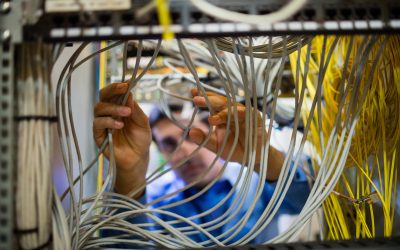Testing Copper Cabling

Tags: certification | coax | copper cabling | training | twisted pair
Field measurements verifying the transmission performance of cabling plant result in a more professional hand-off from the cabling contractor to a customer. This improves the overall effectiveness of providing premises networking solutions, resulting in higher customer satisfaction.
This article present a high level summary of copper testing. The intent of these guidelines is not to duplicate the information in cabling standards, or the contents of individual field tester manuals, but to provide additional information to address issues relevant to the testing of installations. These guidelines should be considered generic to all test equipment.
The document is organized in the natural sequence a user will be involved with a field tester as shown:
- Calibration
- Operation
- Interpretation
- Application Testing
- Upgrades
- Trouble Shooting
Calibration of Field Testers and Test Configurations
Different field test instruments have slightly different calibration procedures. It is important that these procedures are followed. Proper calibration of the field testers is required to ensure accurate measurements.
Calibration of Remote Injector
A short length of tester equipment cord (supplied with the field tester) is used to connect the main unit to the remote unit and the calibration sequence activated from the main unit. This will result in the main unit determining attenuation loss inherent in the testers and calibrate this loss to be 0 dB. Different manufacturers provide different calibration kits. If adapters are needed for the measurement of the installed cabling, it is a good idea to include these adapters in the calibration. This is because adapters are not part of the installed cable plant and should consequently be calibrated out of the attenuation measurement, resulting in better measurement accuracy for attenuation.
Selection of Cable Type
Selecting the cable type closest to the cable being tested will yield better accuracy, especially for length and propagation delay measurements. Often, the field tester is pre-loaded with various cable types. The main result of selecting a cable type is the selection of the nominal velocity of propagation (NVP). Values for NVP are obtained by tester vendors from cable data sheets, or sometimes verbally from individuals representing manufacturers. Consequently, these NVP values are often incorrect or out of date. It is critical that the correct cable type be selected and the NVP determined using the field tester calibration procedure.
Calibration of NVP
Since various testers use different internal procedures to find the pair with the shortest electrical delay (corresponds to maximum velocity of propagation), calibration is the only sure way of initializing the field tester with the right NVP for the particular cable type you are testing. This will result in more accurate length measurements and less variability of length between different pairs within a 4-pair cable.
To calibrate, reel off 25 meters (82 feet) of cable and attach modular jacks to both ends. Note the exact jacket foot marks and determine the length of cable that is cut from the reel. Attach this connectorized cable to the main unit and the remote unit using tester. Select NVP calibration from the menus and enter the length of the cable. Note that since the length is determined from the foot marks on the jacket, it is necessary to make sure that the field tester is set to the appropriate units (metric or U.S. Customary units) before running the calibration command from the main unit. The main unit will display the NVP determined for the cable that you are calibrating. Save this NVP as a default for the appropriate cable type, so that you do not have to re-calibrate NVP again for the same type of cable. If you move on to another installation, you may have a different cable, which requires that you calibrate NVP again.
Field Measurement Procedures
It is important to develop uniform test practices and provide adequate training. Although each cabling customer may have different requirements, it is risky letting each job get tested differently. These units are much more complicated than continuity buzzers, and improper settings or inadequate battery management could waste hours worth of testing. Suitable calibration procedures and intervals must be enforced. For example, calibration of remote unit every day of use is a good practice. Calibration of NVP for each job will ensure that the NVP represents the value of the cable being installed at a site.
Sanity Checks
Any tester should undergo regular checkups, or some form of sanity check. Users should develop some expertise to assess whether a tester is providing useful results. One simple method is to construct a sample link to be used as a reference. Make sure that it is physically protected and not subject to movement. Expect some variation with temperature, humidity, and time, but this is a valid check for malfunctioning units. A link such as this is required for Nominal Velocity of Propagation (NVP) calibration may be used as a reference link and will serve as a simple test to verify the consistency of a field tester. If this same link is used to check periodically for tester repeatability, one will get a useful indication that the field tester is functioning properly.
Use of Interface Adapters
Most of the time, an interface adapter is necessary to attach field testers to the channel/permanent link under test. These adapters are an extra element in the link configuration and may affect the accuracy of a measurement. In general, unknown adapters should be avoided. To measure a permanent link, an adapter cord to interface to the tester is preferred. Test instrument vendors should provide this adapter cord. For channel measurements, testers provide an adapter from the tester interface connector to a modular jack. Again, it is important that only cords and adapters provided by the testers be used to attach field testers to the link under test.
Durability of Connecting Hardware Interfaces
An important issue not yet handled by the testers is keeping track of the life cycle of test interfaces. Any jack or plug has a reliable limit on connect/disconnect cycles. Interfaces should be serialized (marked) and users should keep track of how many tests are performed so their reliable limit is not exceeded. Additional interfaces should be ordered and available for replacement at suitable intervals. It is a good practice to maintain approximate (to the nearest 100) cycles of usage so that plug/jack contacts can be inspected and replaced as necessary. Different testers claim different number of usage cycles for accurate measurements. As a first step these vendor guidelines may be sufficient. If measurements are not repeatable or if the failure rate of links increases, it may be time to replace the plug/jack interfaces.
Interpreting, Saving and Printing Data
Once a measurement has been made, the data has to be interpreted properly. Portions of the data can be printed in a summary report or saved in records that are transferred later into a device or to the cloud. Detailed information necessary to display the data as a graph are available following a test. Site testing requiring only a PASS/FAIL indication should follow the faster autotest and save cycle to optimize testing speed.
Individual and Overall Pass-Fail Results
Individual parameter failures can be one of two types : FAIL, or *FAIL. The * indicates that the failure is questionable because the measured value is so close to the specified limit that the field tester is not sufficiently accurate to resolve the measurement. It is a good idea to check any FAIL or *FAIL parameters to understand what may be the underlying cause. Note that any *FAIL of a single parameter will result in an overall FAIL for the channel.
A *PASS indicates that the result is better than the specified limit, but within the accuracy of the instrument. *PASS for any parameter will be treated as a PASS and if all other parameters are acceptable, the result in an overall PASS for the link under test. The *FAIL and *PASS area of uncertain measurements is often referred to as the “grey zone”.
What to do for a failure
In the unlikely event that a channel fails, it is time to stop and understand what may be the cause of the failure. Note that a failure is a measurement failure and could be caused by the cabling, the tester, poor termination practices, or all of these.
- Ensure that the tester is working properly by checking it against the benchmark /calibration link. If the benchmark link measures within the accuracy limit of a tester, the tester is functioning properly.
- Follow the trouble shooting guidelines from the tester manufacturer for different issues.
- If the trouble has been identified, take corrective action to fix the cabling.
- Re-test to ensure that the corrective action has worked effectively.
Printing Reports
Printing reports is usually done after a continuous set of autotest measurements. Depending on customer preferences, all test results may be printed and signed off by the installer and/or customer. If the customer does not require documentation of the testing, any test results that look odd or have “grey zone measurements” should be marked and printed from the field tester. It is important to use the printer cable supplied with the tester unit and ensure that a compatible printer is used.
Saving Data
For long term data analysis and statistical interpretations, it is a good idea to save all the data into a device or into the cloud. All testers provide some mechanism for uploading data into a device or cloud, and freeing up memory in the field tester for new measured data. This is a good practice that can be used to gain valuable insights into the quality of an installation and as source data for the ongoing administration of the premises network. Often, two levels of data can be transferred to a PC. The primary level is the autotest summary report for each link or channel. A secondary level is detailed graphical data for plotting and/or detailed analysis.
Field Tester Maintenance and Upgrades
Field testers are evolving rapidly and probably have a life cycle as fast as any other IT device ( 2-3 years). Hardware updates are generally not possible and usually involve replacement of the tester. Software upgrades are relatively easy and with the rapid evolution of field testers, are quite frequent. These software upgrades are usually obtained directly by downloading new executable files into a PC and transferring these to the field tester.
This is not an exhaustive list, so if you are interested in learning more, take a look at the Network Test and Inspection courses.

Written by James Donovan
You might also enjoy
FO Connector Contamination – A Constant Threat
Fiber optic communication most commonly works in duplex or multifiber transmission by transmitting light to a receiver in one direction on a fiber and receiving transmitted light back to a second receiver on the second fiber. Most engineers can understand that and...
Why Inspect and Clean Fiber Optic Connectors?
Inspecting and cleaning of fiber optic connectors during installation and when making any patching, is essential. Any contamination on a patch cord connector will be transferred through the coupler to the connector it is mated to. Even when testing fibers with a test...
Cleaning MPOs
MPO connectors should always be inspected with a scope before they are used, be that on a patch cord or a bulkhead. If they need to be cleaned, one-click cleaners are keyed to ensure the tip only fits one way onto the connectors and is able to clean both male and...


